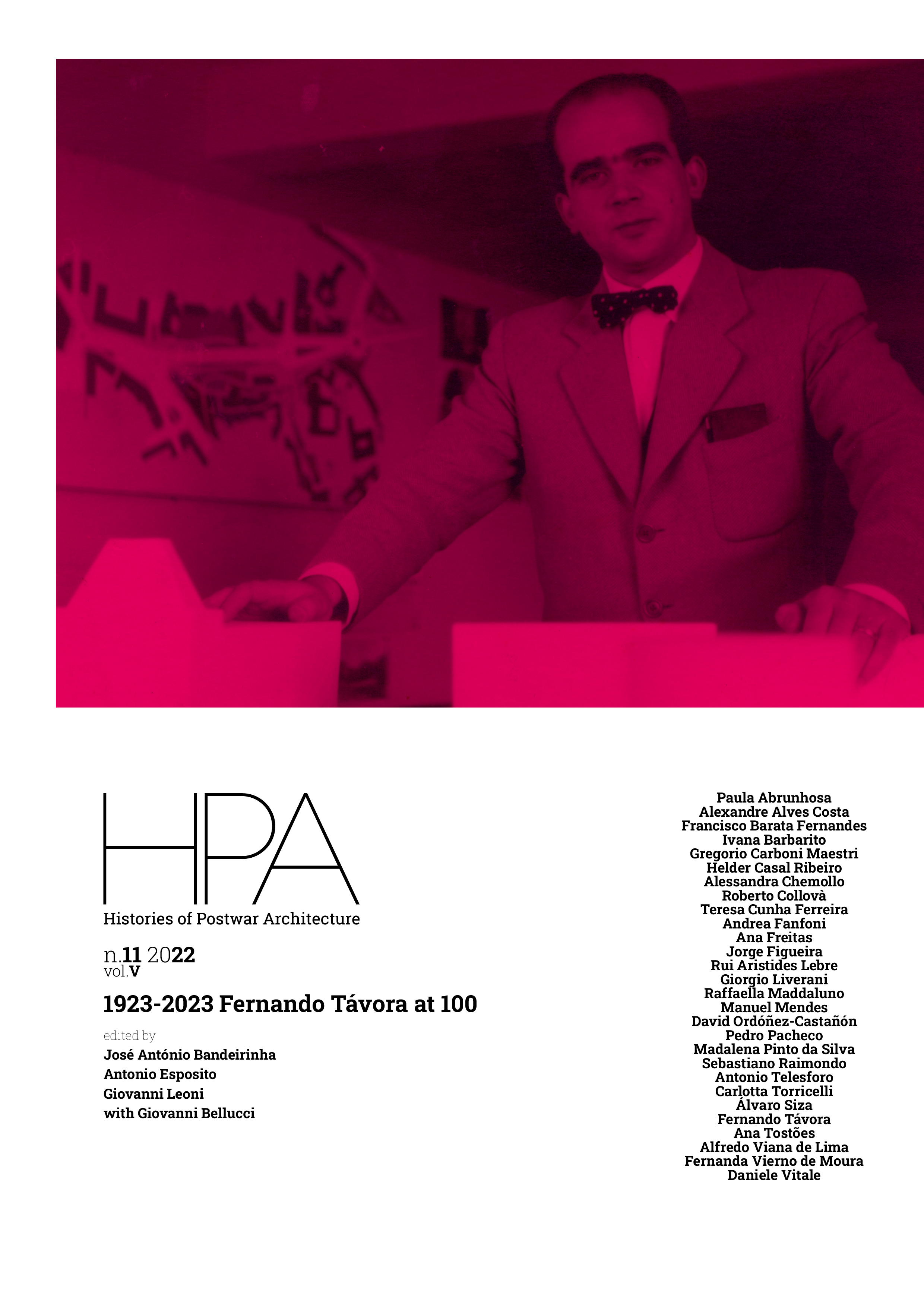Fernando Távora and the Concept for a New Civic Centre for Aveiro: Urban Project, Modernity and the Enhancement of the Urban Landscape
DOI:
https://doi.org/10.6092/issn.2611-0075/17715Keywords:
Fernando Távora, Aveiro, Civic Centre, Urban Project, Revision of the Modern MovementAbstract
This article seeks to explore the importance of the urban project for the Central Zone of Aveiro both from the perspective of the work of Fernando Távora and also as a Portuguese example of the concepts of the Revision of the Modern Movement as they were applied in the early 1960s. We present the project and the historical context of its conception. Fernando Távora’s proposal, started in 1962 along with the master plan for the city, sought to solve urban problems through architectural intervention, thus promoting a new identity through the creation of a new civic centre for the city, which included new road and pedestrian circulation routes, new monumental landmarks in the consolidated urban space, and the intensification of commercial and service use, in addition to housing improvements and land valuation. The project involved a re-reading of the city’s historical attributes and, thus, the buildings designed, despite having a modern character, were intended to promote the appreciation of the historic city and the urban landscape around the city’s Central Canal. In the context of the Revision of the Modern Movement, we view this work as an example of the discussions that took place in the last CIAMs – International Congresses of Modern Architecture.
Downloads
References
Auzelle, Robert. Plano director da cidade de Aveiro. Aveiro: Câmara Municipal de Aveiro, 1964.
Bandeirinha, José António, ed., Fernando Távora: Modernidade Permanente. Matosinhos: Associação Casa da Arquitectura, 2012.
Brites, Joana. Filiais e Agências da Caixa Geral de Depósitos, Crédito e Previdência (1929- 1970). Lisboa: Prosafeita Lda, 2014.
Cao, Lilly. “Lições do único arranha-céu de Frank Lloyd Wright, válidas até hoje”. [The Tree that Escaped the Crowded Forest: Lessons from Frank Lloyd Wright’s Price Tower] (Translated by E. Souza). ArchDaily Brasil, 2022. https://www.archdaily.com.br/br/959013/licoes- do- unico-arranha-ceu-de-frank-lloyd-wright-validas-ate-hoje
Dias, Francisco da S., Dias, Tiago S., and Soares, Maria João. “P01 Arquitectura – Edifício da Antiga Capitania de Aveiro. Arquitetos Francisco da Silva Dias e Tiago Silva Dias”, Arquitectura e Vida, no. 51 (July-August 2004), 44-51.
Esposito, Antonio and Giovanni Leoni. Fernando Távora. Opera Completa. Milano: Electa, 2005.
Fernandez, Sérgio. Percurso da arquitectura portuguesa 1930-1974. Porto: FAUP – Faculdade de Arquitetura da Universidade do Porto, 1988;
Ferrão, Bernardo José. “Tradição e Modernidade na obra de Fernando Távora, 1947-1987”. In Fernando Távora, edited by Luiz Trigueiros, 23-44. Lisboa: BLAU, 1993.
Figueira, Jorge. A Periferia Perfeita. Pós-modernidade na Arquitectura Portuguesa. Anos 1960-1980, Lisboa: Caleidoscópio, 2014.
Grande, Nuno. “Funcionalismo Orgânico. Robert Auzelle e o Plano Director da cidade do Porto”. In Jacques Gréber. Urbanista e Arquitecto de Jardins, edited by Teresa Andersen, Manuel Fernandes de Sá and João Almeida. Porto: Fundação Serralves, 2011.
Juncal, Manuela. “Robert Auzelle e o urbanismo francês dos meados do século XX no ‘Plano Diretor da Cidade do Porto’ de 1962”. Cadernos – Curso de Doutoramento em Geografia. FLUP – Faculdade de Letras da Universidade do Porto, 2012, 61-74.
Matias, Lídia Maria Moreira. “Transformações e integração derivadas da mudança de uso do espaço urbano na cidade de Aveiro, Portugal”. V Seminario Internacional de Investigación En Urbanismo. Barcelona: Universitat Politècnica de Catalunya, 2013. https://doi.org/https://doi.org/10.5821/siiu.5860
Mendes, Carlos Manuel Galante. “Arranjo da zona central de Aveiro, de Fernando Távora (1962-67): das influências teóricas às referências práticas”. Master Diss., Universidade de Coimbra, 2016.
Mesquita, Ana Raquel da Costa. “O melhor de dois mundos: A Viagem do arquitecto Távora aos EUA e Japão –Diário 1960”. Master Diss., Universidade de Coimbra, 2007.
Montaner, Josep Maria. Después del Movimiento Moderno: Arquitectura de la segunda mitad del siglo XX. Barcelona: Editorial Gustavo Gili, 1993.
Mumford, Eric Paul. The CIAM discourse on urbanism, 1928-1960. Cambridge: MIT, 2000, 200.
Portas, Nuno. “Velhos centros vida nova”. In Os Tempos das Formas, vol. I: A Cidade Feita e Refeita, 155-170. Guimarães: Universidade do Minho, 2005.
Ray, Stefano. Sven Markelius 1889-1972. Roma: Officina Edizioni, 1989.
Silva, David Moreira and Martins, Maria José Moreira da Silva. Anteplano de Urbanização da Cidade de Aveiro. Aveiro: Câmara Municipal de Aveiro, 1948.
Solà-Morales, Manuel de. “The Urban Project”. In Progettare città / Designing Cities, edited by Mirko Zardini, Milan: Electa, 1999.
Tavares, Domingos. Fernando Távora em Aveiro, Porto: Dafne Editora, 2022.
Távora, Fernando. Arranjo arquitetônico e urbanístico da Zona Central. Estudo Prévio. Memória descritiva e justificativa. Aveiro: Câmara Municipal de Aveiro, 1963.
Távora, Fernando. Teoria geral da Organização do Espaço. Arquitectura e Urbanismo: A lição das constantes, Porto: FAUP Publicações, 1993.
Távora, Fernando. Da Organização do Espaço, Porto: FAUP Publicações, 1996.
Távora, José Bernardo, ed., Atlas Aveiro – Edifício Fernando Távora, Biblioteca Municipal, Projeto e obra 1964-2020. Aveiro: Câmara Municipal de Aveiro, 2021.
Downloads
Published
How to Cite
Issue
Section
License
Copyright (c) 2022 Fernanda Vierno de Moura

This work is licensed under a Creative Commons Attribution 4.0 International License.





